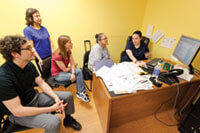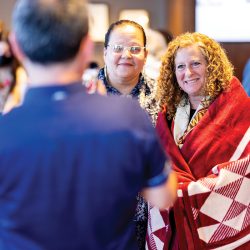Books and Beyond

During a class session held at the Ho-Chunk’s Wisconsin Dells Youth & Learning Center in Baraboo, Janice Rice (left, in blue) and her students show the center’s teachers an online cataloging system. Photo: Bryce Richter.
A newly formed course explores how libraries and museums can preserve tribal culture.
For the Red Cliff Band of Lake Superior Chippewa, the idea for a tribal library is driven by a vision of creating strong cultural ties from generation to generation.
Such a facility could serve as a cultural center, provide archival storage, and house space where elderly tribe members could interact with school-aged children in an Ojibwe language immersion program, says Dee Gokee-Rindal, administrator for the tribe’s education division.
“That’s the way that our ancestors have shared indigenous knowledge throughout the centuries — the interaction of younger folks and the elders together,” she says.
Work on the facility is progressing with the help of students from UW–Madison’s School of Library and Information Studies who are enrolled in LIS 640: Tribal Libraries, Archives, and Museums, a course suggested by graduate students three years ago. Classes are aimed at supporting Wisconsin’s Native American nations while also giving hands-on experience to future librarians. Public libraries often don’t reach into native communities, nor do the tribes have the same revenue streams to support their own facilities.
“The assumption is that things can be funded by casinos, but the libraries are very aware that you can’t count on something like that,” says Hannah Gray ’07, MA’11. “There are a lot of different things that need to be funded when there’s not a tax base.”
Libraries, archives, and museums for Wisconsin’s tribes vary widely, says Janice Rice, MA’75, a member of the Ho-Chunk Nation and an associate lecturer in the library school who co-teaches the course. While some, such as the Oneida Nation, Lac Courte Oreilles, and Forest County Potawatomi, have state-of-the-art, multiple-use facilities, others don’t have libraries of any kind or no longer support them.
“Indigenous knowledge takes many forms,” says Omar Poler ’07, MA’10, who helped to organize the first class while a graduate student. Poler is a member of the Mole Lake Sokaogon Chippewa community and was Rice’s co-teacher in spring 2011. “Tribal libraries are interpreting their story themselves and sometimes incorporating language and culture in ways that make them very different from a regular public library.”
Although the course is housed in the library school, it also serves as a class in Native American history, language, art, culture, anthropology, law, and education. It touches on libraries, archives, and museums because they are intertwined in native communities, says Jessica Miesner MAx’12.
“It’s impossible to talk about one without the other two,” she says. “Often there’s funding for one but not others, and everything is housed in one place.”
A key component of the course is the opportunity for service learning. The students who enroll in the course are universally drawn by the chance to get real-world library experience.
Some of the students also assist with Culture Keeper, a series of conferences that provide a way for tribal librarians, archivists, and museum curators to come together and share ideas.
“As library school students, we are in a unique position to provide help, skills, and resources that can be hard to come by for many tribal libraries,” says Kelly Kramer MAx’12, a member of the Oneida Nation. “Native Americans are one of the most underserved populations out there when it comes to library services, and I think we have a responsibility to include Wisconsin tribes in what we do.”
Involving UW students in such activities inspires tribes to find ways to organize and create space for history, language, and culture in their communities, Rice says. Last spring, Gray and fellow students developed fundraising materials to help the Red Cliff tribe with the library project that members hope to complete in the next few years. Kramer and her group worked with staff at the Ho-Chunk’s Wisconsin Dells Youth & Learning Center to build an online catalog of a fifteen hundred-volume collection to promote reading. In time, the library will feature subject headings on shelves in both Ho-Chunk and English.
“The students’ youthful energy and their untapped potential helps Native American communities to see that there are people who are excited about tribal libraries,” Rice says.
Published in the Fall 2011 issue



Comments
Gabe October 19, 2011
Go TLAM!